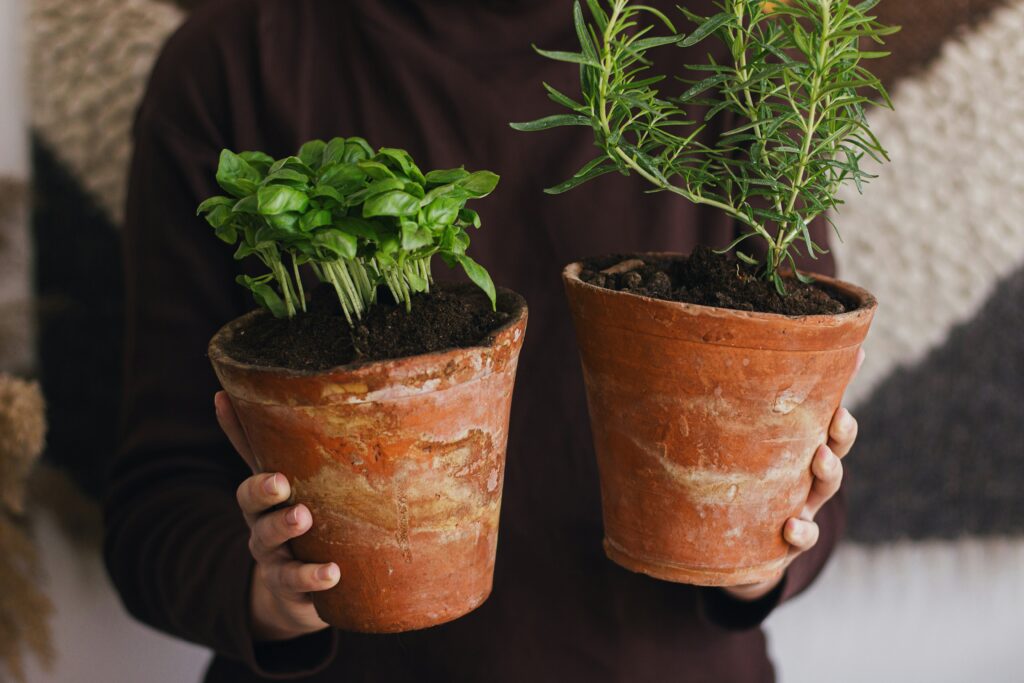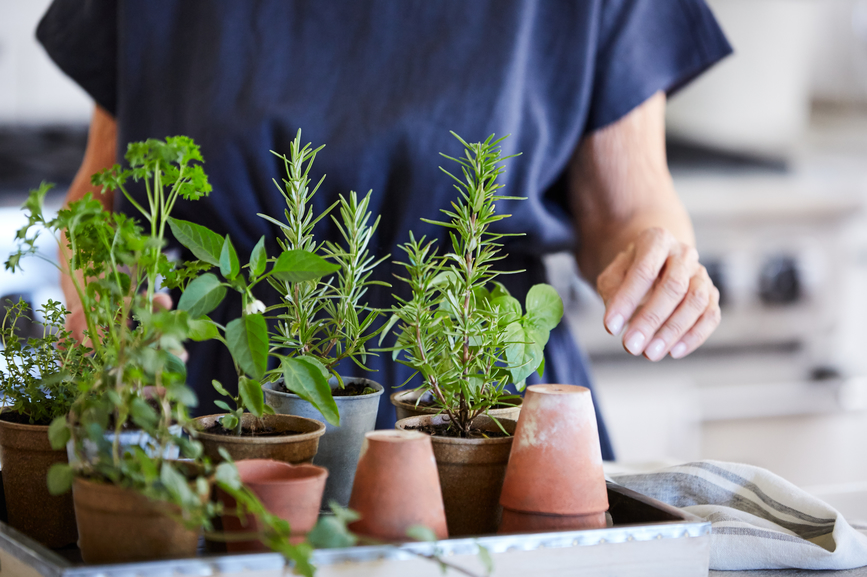Truly, there’s no greater pleasure than harvesting something right in your own kitchen or home. Plus, not only do you enjoy their delectable tastes and nostalgic smells, but their biophilic impact will be felt by all. We review our favourites to grow, with tips and tricks to achieving success for our top picks.
The Secrets to Growing Herbs Indoors
Just like any green thumb endeavour; growing herbs indoors isn’t challenging, so long as you pay attention to the few major points needed.
Light
The first point on our essential list is adequate light. Big, bright windows are wonderful; if you have them. For the those who don’t have consistent, or strong lighting in and around their intended spaces, i.e,. kitchens, introduce grow-lights. Bulky, metal structures may come to mind, but we’re pleased that now there are plenty of aesthetic and beautiful lighting options to choose from. Additionally, you can forgo a system and opt for a light bulb or lighting strip that can seamlessly be hidden in any space. If you are growing via natural light and start seeing your herbs thinning out or becoming spindly, it’s an excellent indicator that lesser hours of daylight are just not enough to keep your plant happy.
Container
Many herbs have fairly extensive root systems. When possible, opt for larger containers; to allow those systems to have their needed space. If you purchase your herbs as transplants, repot into at least a 6-8″ pot. If you’re low on space, it’s better to select a few favourites, giving each their own larger area, rather than having more in smaller containers.
Julie’s Notes: Remember that your watering frequency will be affected by the size of your container or pot. Smaller containers require significantly more watering as there is less soil volume. As consistency is key, size-up to avoid the need for super-diligence.
Soil + Watering
As mentioned above, watering is impacted by the size of the container, but what’s additionally important is the watering needs of each herb. As you enter the late fall and winter months, plants begin to naturally slow down. Their water uptake is lessened and overwatering can then become a problem. And further exasperated by certain plants simply liking dryer conditions. Herbs indoors need to be carefully monitored, in a slightly different way than when grown outdoors. Whereas outdoors, we can opt to have a schedule, indoors, we want to check in more frequently and water accordingly. Simply stick you finger into the soil, to about the first knuckle. Then depending on the specific needs of your herb, act accordingly. Something like basil, likes evenly moist soil versus thyme, which does better being watered once the soil has dried out.
Indoors, it’s fairly safe to opt for well draining soil. As overwatering is often to blame for poor growth and herb demise, having a strong soil mixture can go a long way.
Our Favourites
Basil
A true fan-favourite. Basil is versatile, has a heavenly smell and grows quickly. The downside however, is that it has a very short life comparably and requires constant succession planting or propogration. You can start it from seed, or pick up even a grocery store transplant. When harvesting, always trim the entire stem at a point just above two small leaves. This encourages two new stems to grow in place of the cut creating a hydra effect.
Thyme
An impactful scent and a natural choice for pairing with many types of meats and hearty root vegetables. Thyme is essential to many cuisines around the world. On top of its uses from a culinary point of view, we appreciate the tiny leaves and dainty but beautiful appearance. Clay and terracotta pots are an excellent choice as their aged patina is a striking contrast to the soft green and yellow hues of this plant. Water only when soil is dry.
Oregano
With a scent that will whisk you away to the Mediterranean; it’s a beautiful pick me up on the coldest (and darkest) days of the year. Oregano, can be somewhat wild outdoors, growing quickly, spilling out of their pots of or spreads in ground. But when grown indoors, it’s fuzzy leaves tend to more controlled and subtle. We love oregano as a little snip of a fresh plant can go a long way. Often, we’ll try and find a larger plant to begin with as growing from seed or small transplant can be tedious. Oregano is sun-lover. Even if you have a great window, for this herb, consider adding an extra source of light.
Parsley
Easy on the watering as parsley is susceptible to root rot and does prefer to dry out between waterings. For the most part both the curly and flat-leaf variety grow well. Keep in mind this is a biennial plant which means if successfully grown for two-years it will flower and then eventually expire. In that second year; start a new plant by taking several cuttings, propagating in water before transferring back to soil.
Rosemary
Another kitchen staple, rosemary enhances the savoury notes of dishes, lends a wonderful, fresh, fragrance and just looks wonderful potted. But, it is one of the hardest indoor herbs. The reason being that it requires attention that is fairly different than the other herbs on the list, and many other houseplants as well. The trick it to mimic its natural habitat. “Dry feet, moist foliage”; meaning that due to arid conditions it hails from, it likes to take it water from the environment. Spritz the leaves weekly, or place your pot where it has access to water sources like a kitchen sink; and let your plant “drink” by placing the pot in water for about an hour or so whenever the soil is dry.
A Note on Harvesting
Growth will rarely be as vigorous indoors as you may have come to expect in your garden. With that in mind, a little goes a long way. Basil, as mentioned can be encouraged to send out new shoots if cut above a leaf set, but once its been growing for several weeks you can do a full cut. Parsley works similarly and can handle a big trim. For slower growers like rosemary, oregano and thyme, take stems leaving about 1/3 remaining, and always before any flowers form.
May your herbs be plentiful and the meals they compliment delicious. For more reading and inspiration on all things home, gardening and lifestyle? Check out the The Wild Blog. Plus, if you don’t already, be sure to follow us on Instagram and Pinterest!






